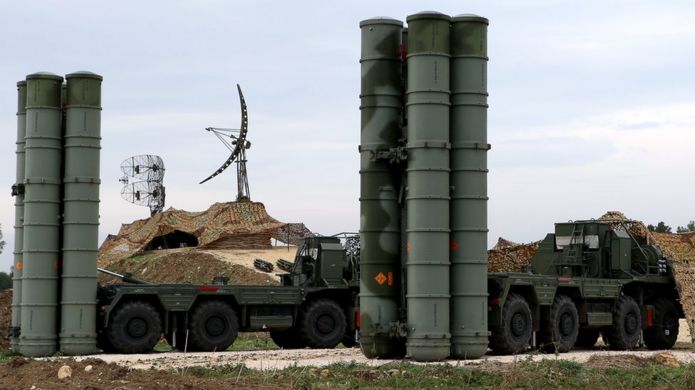Syria, a Middle Eastern country, was a battle zone for world powers in the last decade. It was also the testing ground for some of the most advanced weapons on earth.
Moscow provided Syria with its advanced air defense systems including S-300 in 2018 and also deployed S-400 Triumf to defend its airbases and important installations on Syrian soil.
The S-400 air defense system is developed by Almaz Central Design Bureau, used to engage all kinds of aircraft, and medium and long-range ballistic missiles including hypersonic targets. It has a maximum detection range of up to 600 km.
Follow us on Google News to get the latest defense news and analysis
The deployment of S-400 in Syria including other sophisticated systems “make the situation even more complex”. Because many other nations are operating in the same Syrian airspace and it is difficult for such systems to identify friends or enemies in the complex combat environment. A senior NATO diplomat acknowledged.
The one reason for the deployment of the most advanced, long-range S-400 SAM Growler in Syria from the Russian military was a series of incidents that happened. In 2015, Turkish fighters shot down the Russian Su-24 fighter aircraft. While in another incident the Syrian air defense unit accidentally engaged and destroyed the Russian electronic-intelligence aircraft with 15 personnel on board were killed.
Russia accused Israel of the incident because of the continuous airstrikes from the Israeli Air Force to the Syrian sensitive installations. The other reason for the incident is the continuous Syrian airspace violations from the Israeli side, due to which the Syrian military was using its air defense systems extensively.
Syrian civil war background:
The geographical importance and the oil-rich fields of the Middle East always attract other countries. Syria is an Islamic country. Its boundaries touch the Mediterranean sea and is surrounded by the Islamic and non-Islamic states.
The unrest in Syria was started back in 2011 in the form of an armed protest against the Syrian regime. The protest was later converted into a full-fledged civil war and lasted about a decade.
The great powers including the USA, Russia, the Kingdom of Saudi Arabia, and other nations have their own interests in the region and they directly or indirectly took part in the Syrian war.
Russia as a Syrian government’s ally provided them with the assistance to mitigate the threats from armed organizations which were constantly attacking the country’s important and sensitive installations including those belonging to the army and civil governments.
Need of S-400 in Syria:
In the complex combat environment in Syria since 2011, the Syrian military seeks a solid air defense system from its ally Russia. Russia as a world-leading defense weapons exporter also produced some of the most successful, battle-proven air defense systems.
As the Syrian military was already operating the Russian S-200 air defense system but it was not much effective against the more advanced fighter jets of the Israeli Air Force. To defend its airspace Syria wanted to acquire the S-300 air defense system from Russia.
Russia has deployed the surface-to-air S-400 Triumf air defense system to defend its military bases and other sensitive installations in the Syrian complex battle environment. Also, Russia wanted to test the air defense system in the combat zone. Because the S-400 was never used in a real combat environment before.
According to a BBC report, “The S-400 is one of the most modern air defense systems with an extraordinary reach. From the airbase near Latakia the S-400s surface-to-air missiles could strike targets in an arc that takes in much of Israel, the Eastern Mediterranean (including Cyprus where British jets are based), and Northwards to cover a large part of Turkey beyond the Syrian border.”
The NATO Secretary-General Jens Stoltenberg once said that Russia was deploying sophisticated ‘anti-access capabilities’ from the Baltic, through Ukraine and Crimea, to the Eastern Mediterranean to constrain NATO deployments in the event of any crisis.
The S-400 was not used as extensively as needed due to the complex Syrian battle zone situation. The Syrian air defense units use S-300 against the Israeli warplanes but they have a little effect so far.
According to an Israeli defense analyst, Tal Inbar told Breaking Defense that the S-300 and S-400 have never been proven in action against advanced fighters.
There are many countries that wanted to buy S-400 from Russia. Even the NATO member Turkey has already purchased the S-400 air defense system. While some other NATO members including Bulgaria, Greece, and Slovakia are already using the S-300.
Analysis:
The use of air defense systems depends on the situation it is used in and the capability of the force using it. In the case of Syria, firstly the situation is very complex because many countries are using their airspace as a battle zone and it is very difficult to identify and engage the target in such a short time. Secondly, the Syrian forces are not as highly trained to use such an advanced air defense system in such a situation. This definitely affects the capacity of the system.
By considering these above factors, we could not underestimate the capability of such an advanced air defense system. We still have to wait to see the full capabilities of the S-400 SAM system in the real combat environment.


